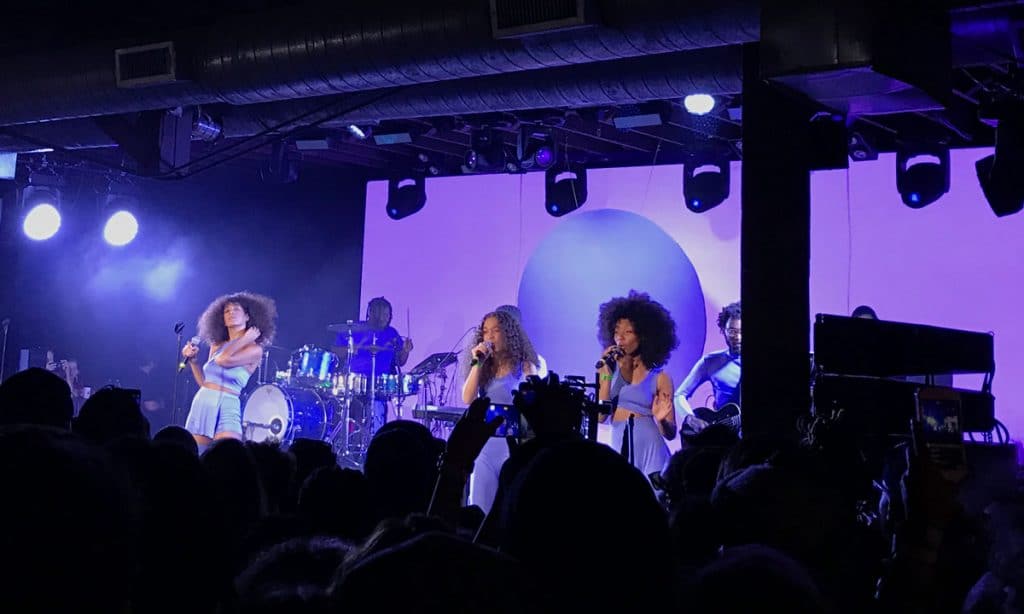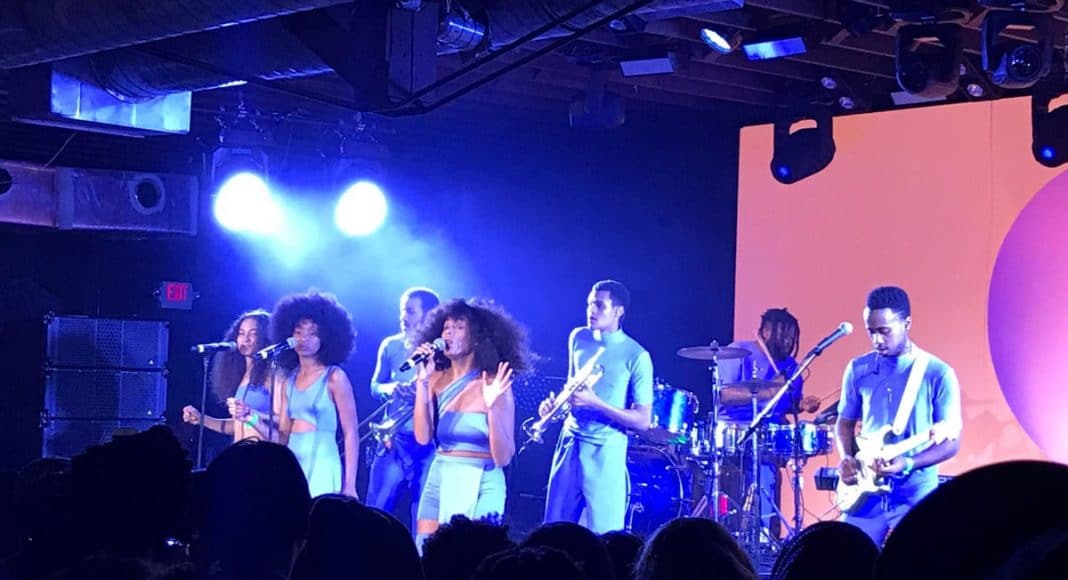Solange does not need your approval. Solange does not notice if you’re watching. Solange is there to do exactly what Solange wants—to express the full range of Solange in all her glowing intricacies and brilliant idiosyncrasies.
Solange was the final member to grace the stage of her Saint Heron band Wednesday night at YouTube’s South by Southwest showcase. There had been no opening act and though some expected hip hop and pop tunes jammed, no DJ was pushing and prodding the crowd into hysteria. The only pre-show lubricant was one you come to expect at a SXSW show: free drinks.
Any true fan excitement was mostly kept under wraps, was contained internal. The crowd delivered an enthusiastic cheering and clapping when Solange approached the microphone, then a return within. When I think of Solange’s music, particularly her exceptional 2016 release A Seat At The Table, certain words like elegant, arty, self-affirmed, and mesmerizing can’t help but spring to mind. Through her songs Solange captures a vibe that you feel more than you hear, more loving like a hug than a seductive whisper.
Up on stage, performing, it was more comparable to watching an art installation than any other concert I’ve attended, during SXSW or ever. Solange and the band wore these bluish-purple silk garbs; they weren’t flashy, though the material itself was shiny. It unified them as they danced their choreographed movements with bops and shakes; they moved in sync as one, almost like they were all operating from some collective brain. Light that same bluish-purple color cast Solange and the band in its glow, but it remained mostly a static presence, no wild light show or strobing pulses.

All these performative impressions conduct the same effect so much of Solange’s music does. She strips everything down to its barest quality, its purest status, chasing the roots of a thing. Away with the distracting conventions that embody so much of popular music and shows, away with who I’m supposed to be, she’s saying, this is who I am. That’s an incredibly difficult place for any person to reach, let alone an artist expressing that position in a genuine, believable matter.
Her confidence in her music and on stage intoxicates as her arms glide like they’re riding waves through the air and she flips that bold, beautiful hair of hers. You can watch—and you do want to watch—but no you can’t touch. A measured thoughtfulness emanates her movements, everything done so considerably and exactly. A bartender told me before the show Solange ran through a 90-minute sound check—an absurd amount of time for most artists—and kicked the staff out when a few were caught filming. This meticulous nature is why you love Solange: she is so sure of how she wants to be presented and represented in the world, and accepts nothing less.
Then she played “Cranes In The Sky.” I can’t assume how anyone else hears that song, but when those drums kick in, cymbals crashing, that grand combustion of rhythm, I never experience it through any traditional senses. It—and, yes, I’m aware how this sounds—ignites from some deep forever place inside me. Not like my soul, because that seems corny and somehow reductive, but more elemental, like my core, or something of that nature. Solange enters the arrangement with this gentle falsetto—I tried to drink it away—so nakedly, so tenderly while those elongated, rich strings tether the emotional crevice in between those expressions. The whole experience grounds you and lifts you up simultaneously. You want to cry and smile at the same time.
That’s how it felt in the crowd, anyways. Judging by the many fans swaying and arms shooting high, palms outstretched, we all seemed to agree about the moment. So much of why any of us attend these concerts, waiting for hours desperately hoping we get in, is to access that special almost-ESP communication only possible in this environment. It goes beyond the idea of, These are my people, though that’s part of it. It’s that open line suddenly available with your favorite artists, with these people who seem to understand you, even if it’s as simple as the call-and-response of “Yeah!” when a rapper or singer screams, “Y’all having a good time tonight!?” Great artists give you more than that, talking directly to you, like Bruce’s stories and Kanye’s speeches, and the whole event connects you deeper than you previously were before.
-
Related Story: “TFT Exclusive: Dave Matthews On Tim Reynolds Collaboration, Trump’s Wall, And Going Vegan”
So it was strange when Solange didn’t acknowledge the crowd’s presence until she was more than halfway through her set. Each record bled into the next, creating this tapestry of her performance. She sang in suites, not songs. Yet I’ve never felt such a good-natured vibe networked between crowd and artist. We didn’t need her to chat with us. It was almost like how older couples don’t talk as much, because their actions say enough or you already understand what the other meant.
When Solange did finally address the audience, thanking their attendance near night’s end, it was done sweetly, not out of any sense of obligation. She had completed her goal that night, showcasing what she wanted to say to us. We had all grown together, reaching the roots of the thing, and now were fluent in Solange’s language. Somehow, you too felt like you didn’t need this approval, this acknowledgment of someone watching you. But when Solange delivered exactly that, you knew precisely what place it was coming from.
[gravityform id=”13″ title=”false” description=”true”]


